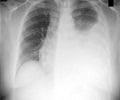
The work was performed by a group of scientists from the Catholic University of Rome, the National Institute of Infectious Diseases "L. Spallanzani" of Rome.
TB is an infection caused by Mycobacterium tuberculosis, the bacterium known as Koch's bacillus, named after its discoverer (Robert Koch) in 1882. Following infection with the bacillus, two different scenario may occur: "active disease", clinically evident, and that - if not properly treated - can lead to death and the so called "latent infection", that is asymptomatic and that can last for a lifetime.
"The tuberculin skin test- explains Delia Goletti, corresponding author of the paper - has several drawbacks, primarily that is unable to differentiate between infection with environmental mycobacteria (typically not dangerous to humans), vaccination with Bacillus of Calmette et Guerin (BCG) and infection with M. tuberculosis. A new assay is being used since ten years, which includes a blood test, based on specific proteins of Mycobacterium tuberculosis. The new blood test, called "Interferon-? release assays (IGRA)", based on the release of interferon-? in response to M. tuberculosis-specific antigens, is able to selectively identify those who have contracted TB infection.
"However - continues Goletti - IGRA, as well as the tuberculin test, are not able to distinguish people with latent TB infection compared to those with active TB disease ".
"The results of our study", said Giovanni Delogu, first author of the article, - demonstrate that it is possible to distinguish those infected from those with the disease, by simply performing an extra blood test using a protein of the bacillus named HBHA".
Advertisement
"In this study we have developed an innovative diagnostic algorithm, which consists of a response to the protein HBHA in combination with the IGRA and the results have shown that the response to HBHA associates with latent TB infection. This procedure allows to rapidly identify those who really need the treatment for active TB ", concluded Goletti.
Advertisement
"These results - concludes the researchers - open the road to a multicenter study-"In the future we plan to extend the study to a larger number of patients, giving priority to certain groups where diagnosing active TB can be challenging, such as immunocompromised individuals and children. We also plan to tests the new assay in countries with a high burden of TB".
The study has been published on the international journal PLoS One.
Source-ANI











